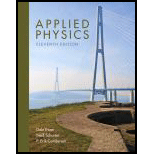
Applied Physics (11th Edition)
11th Edition
ISBN: 9780134159386
Author: Dale Ewen, Neill Schurter, Erik Gundersen
Publisher: PEARSON
expand_more
expand_more
format_list_bulleted
Concept explainers
Textbook Question
Chapter 21, Problem 12RP
An object 4.50 cm tall is placed 20.0 cm from a converging lens. A real image is formed 12.0 cm from the lens. (a) What is the focal length of the lens? (b) What is the size of the image?
Expert Solution & Answer
Want to see the full answer?
Check out a sample textbook solution
Chapter 21 Solutions
Applied Physics (11th Edition)
Ch. 21.5 - Given so = 1.65 cm and st = 6.00 cm, find f.Ch. 21.5 - Given f = 15.0 cm and st = 3.00 cm, find so.Ch. 21.5 - Given st = 14.5 cm and f = 10.0 cm, find so.Ch. 21.5 - Given st = - 10.0 cm and f = - 5.00 cm, find so.Ch. 21.5 - Given so = 7.35 cm and st = 17.0 cm, find f.Ch. 21.5 - Given ht = 2.75 cm, ho = 4.50 cm, and st = 6.00...Ch. 21.5 - Given ho = 12.0 cm, st = 13.0 cm, and so = 25.0...Ch. 21.5 - Given ht = 3.50 cm. hs = 2.50 cm, and st = 15.5...Ch. 21.5 - If an object is 2.50 m tall and 8.60 m from a...Ch. 21.5 - An object 30.0 cm tall is located 10.5 cm from a...
Ch. 21.5 - Prob. 11PCh. 21.5 - An object 12 6 cm in front of a convex mirror...Ch. 21.5 - What is the height of an image in a truck mirror...Ch. 21.5 - A lift truck has a rear view mirror that is 0.76 m...Ch. 21.5 - Find the focal length of a convex mirror that...Ch. 21.5 - Find the focal length of a mirror that forms an...Ch. 21.5 - Find the focal length of a mirror that forms an...Ch. 21.5 - An image of a statue appears to be 11.5 cm behind...Ch. 21.5 - (a) What is the height of a figurine 7.33 cm in...Ch. 21.10 - Find the index of refraction of a medium for which...Ch. 21.10 - Prob. 2PCh. 21.10 - If the index of refraction of a liquid is 1.50,...Ch. 21.10 - The angle of incidence of light passing from air...Ch. 21.10 - If the critical angle of a liquid is 42.4, find...Ch. 21.10 - If the index of refraction of a substance is 2.45,...Ch. 21.10 - A converging lens has a focal length of 15.0 cm....Ch. 21.10 - An object 2.50 cm tall is placed 20.0 cm from a...Ch. 21.10 - The focal length of a lens is 5.00 cm. How far...Ch. 21.10 - If the distance from the lens in your eye to the...Ch. 21.10 - An object 5.00 cm tall is placed 15.0 cm from a...Ch. 21.10 - An object 4.50 cm tall is placed 18.0 cm from a...Ch. 21.10 - What are the size and location of an image...Ch. 21.10 - What are the size and location of an image...Ch. 21.10 - What is the focal length of a convex lens that...Ch. 21 - Stained glass is an example of a. a transparent...Ch. 21 - A virtual image may be a. larger than the object....Ch. 21 - A real image may be a. erect. b. shown on a...Ch. 21 - Explain the difference between diffusion and...Ch. 21 - Prob. 5RQCh. 21 - Prob. 6RQCh. 21 - Describe the type of images formed by plane...Ch. 21 - Explain the difference between real and virtual...Ch. 21 - Explain the difference between a concave and a...Ch. 21 - Explain the effect of spherical aberration.Ch. 21 - For a mirror of given focal length, how does the...Ch. 21 - For a given object distance from a mirror, how...Ch. 21 - The index of refraction depends on a. the focal...Ch. 21 - Snell's law involves a. the lens equation. b. the...Ch. 21 - Prob. 15RQCh. 21 - Give several examples of total internal...Ch. 21 - Prob. 17RQCh. 21 - Prob. 18RQCh. 21 - Prob. 19RQCh. 21 - What types of images are formed by diverging...Ch. 21 - What types of images are formed by converging...Ch. 21 - How do water waves affect the escape of light from...Ch. 21 - Explain why a fish under water appears to be at a...Ch. 21 - Does light always travel in a straight line?...Ch. 21 - Explain how total internal reflection allows light...Ch. 21 - Under what conditions will a converging lens form...Ch. 21 - Under what conditions will a converging lens form...Ch. 21 - Under what conditions will a diverging lens form a...Ch. 21 - Using 1f=1s0+1si, s0 = 3.50 cm, and si = 7.25 cm,...Ch. 21 - Using 1f=1s0+1si, s0 = 8.50 cm, and f = 25.0 cm,...Ch. 21 - Using M=hih0=sis0, h0 = 6.50 cm, si = 7.50 cm, and...Ch. 21 - If an object is 3.75 m tall and 7.35 m from a...Ch. 21 - An object 43.0 cm tall is located 23.4 cm from a...Ch. 21 - Prob. 6RPCh. 21 - The angle of incidence of light passing from air...Ch. 21 - If the index of refraction of a liquid is 1.44,...Ch. 21 - If the critical angle of a liquid is 45.6, find...Ch. 21 - If the index of refraction of a substance is 1.50,...Ch. 21 - A converging lens has a focal length of 12.0 cm....Ch. 21 - An object 4.50 cm tall is placed 20.0 cm from a...Ch. 21 - The focal length of a lens is 4.00 cm. How far...Ch. 21 - What is the focal length of a convex lens that...Ch. 21 - What is the focal length of a mirror that forms an...Ch. 21 - What are the size and location of an image...Ch. 21 - What is the speed of light passing through a...Ch. 21 - Prob. 18RPCh. 21 - Find the focal length of a concave mirror with an...Ch. 21 - Prob. 20RPCh. 21 - Tamera uses a concave mirror when applying makeup....Ch. 21 - A convex security mirror has a radius of curvature...Ch. 21 - Prob. 3ACCh. 21 - Diamonds are cut to take advantage of internal...Ch. 21 - A photographer uses a 60.0-mm lens. (a) How far...
Additional Science Textbook Solutions
Find more solutions based on key concepts
One mole of an ideal monatomic gas is confined to a rigid container. When heat is added reversibly to die gas, ...
University Physics Volume 2
Choose the best answer to each of the following. Explain your reasoning. The reason we do not have a solar ecli...
The Cosmic Perspective Fundamentals (2nd Edition)
11. It takes Harry 35 s to walk from x = ?12 m to x = ? 47 m What is his velocity?
College Physics: A Strategic Approach (3rd Edition)
11. (II) The work done by an external force to move a -6.50 µC charge from point A to point B is J. If the char...
Physics: Principles with Applications
Q36.15 Why is a diffraction grating better than a two-slit setup for measuring wavelengths of light?
University Physics (14th Edition)
For a solid, we also define the linear thermal expansion coefficient, a, as the fractional increase in length p...
An Introduction to Thermal Physics
Knowledge Booster
Learn more about
Need a deep-dive on the concept behind this application? Look no further. Learn more about this topic, physics and related others by exploring similar questions and additional content below.Similar questions
- You view an object by holding a 2.5 cm-focal length magnifying glass 10 cm away from it. How far from your eye should you hold the magnifying glass to obtain a magnification of 10 ?arrow_forwardWhat is the magnification of a magnifying lens with a focal length of 10 cm if it is held 3.0 cm from the eye and the object is 12 cm from the eye?arrow_forwardWhat is the focal length of a magnifying glass that produces a magnification of 3.00 when held 5.00 cm from an object, such as a rare coin?arrow_forward
- How far should you hold a 2.1 cm-focal length magnifying glass from an object to obtain a magnification of 10 x ? Assume you place your eye 5.0 cm from the magnifying glass.arrow_forwardUnder what circumstances will an image be located at the focal point of a spherical lens or mirror?arrow_forwardAn object of height 3.0 cm is placed 5.0 cm in front of a converging lens of focal length 20 cm and observed from the other side. Where and how large is the image?arrow_forward
- A converging lens made of crown glass has a focal length of 15.0 cm when used in air. If the lens is immersed in water, what is its focal length? (a) negative (b) less than 15.0 cm (c) equal to 15.0 cm (d) greater than 15.0 cm (e) none of those answersarrow_forwardTwo stars that are 109km apart are viewed by a telescope and found to be separated by an angle of 105 radians. If the eyepiece of the telescope has a focal length of 1.5 cm and the objective has a focal length of 3 meters, how far away are the stars from the observer?arrow_forwardA convex mirror with a radius of curvature of 25.0 cm is used to form an image of an arrow that is 10.0 cm away from the mirror. If the arrow is 2.00 cm tall and inverted (pointing below the optical axis), what is the height of the arrows image?arrow_forward
- Au object of height 3.0 cm is placed at 25 cm in front of a diverging lens of focal length 20 cm. Behind the diverging lens, there is a converging lens of focal length 20 cm. The distance between the lenses is 5.0 cm. Fluid the location and size of the final image.arrow_forwardAn object viewed with the naked eye subtends a 2° angle. If you view the object through a 10 x magnifying glass, what angle is subtended by the image formed on your retina?arrow_forwardWhat range of magnification is possible with a 7.0 cm-focal length converging lens?arrow_forward
arrow_back_ios
SEE MORE QUESTIONS
arrow_forward_ios
Recommended textbooks for you
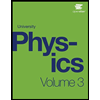 University Physics Volume 3PhysicsISBN:9781938168185Author:William Moebs, Jeff SannyPublisher:OpenStax
University Physics Volume 3PhysicsISBN:9781938168185Author:William Moebs, Jeff SannyPublisher:OpenStax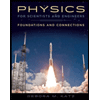 Physics for Scientists and Engineers: Foundations...PhysicsISBN:9781133939146Author:Katz, Debora M.Publisher:Cengage Learning
Physics for Scientists and Engineers: Foundations...PhysicsISBN:9781133939146Author:Katz, Debora M.Publisher:Cengage Learning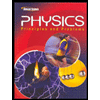 Glencoe Physics: Principles and Problems, Student...PhysicsISBN:9780078807213Author:Paul W. ZitzewitzPublisher:Glencoe/McGraw-Hill
Glencoe Physics: Principles and Problems, Student...PhysicsISBN:9780078807213Author:Paul W. ZitzewitzPublisher:Glencoe/McGraw-Hill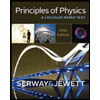 Principles of Physics: A Calculus-Based TextPhysicsISBN:9781133104261Author:Raymond A. Serway, John W. JewettPublisher:Cengage Learning
Principles of Physics: A Calculus-Based TextPhysicsISBN:9781133104261Author:Raymond A. Serway, John W. JewettPublisher:Cengage Learning Physics for Scientists and Engineers, Technology ...PhysicsISBN:9781305116399Author:Raymond A. Serway, John W. JewettPublisher:Cengage Learning
Physics for Scientists and Engineers, Technology ...PhysicsISBN:9781305116399Author:Raymond A. Serway, John W. JewettPublisher:Cengage Learning

University Physics Volume 3
Physics
ISBN:9781938168185
Author:William Moebs, Jeff Sanny
Publisher:OpenStax

Physics for Scientists and Engineers: Foundations...
Physics
ISBN:9781133939146
Author:Katz, Debora M.
Publisher:Cengage Learning

Glencoe Physics: Principles and Problems, Student...
Physics
ISBN:9780078807213
Author:Paul W. Zitzewitz
Publisher:Glencoe/McGraw-Hill

Principles of Physics: A Calculus-Based Text
Physics
ISBN:9781133104261
Author:Raymond A. Serway, John W. Jewett
Publisher:Cengage Learning

Physics for Scientists and Engineers, Technology ...
Physics
ISBN:9781305116399
Author:Raymond A. Serway, John W. Jewett
Publisher:Cengage Learning
Convex and Concave Lenses; Author: Manocha Academy;https://www.youtube.com/watch?v=CJ6aB5ULqa0;License: Standard YouTube License, CC-BY